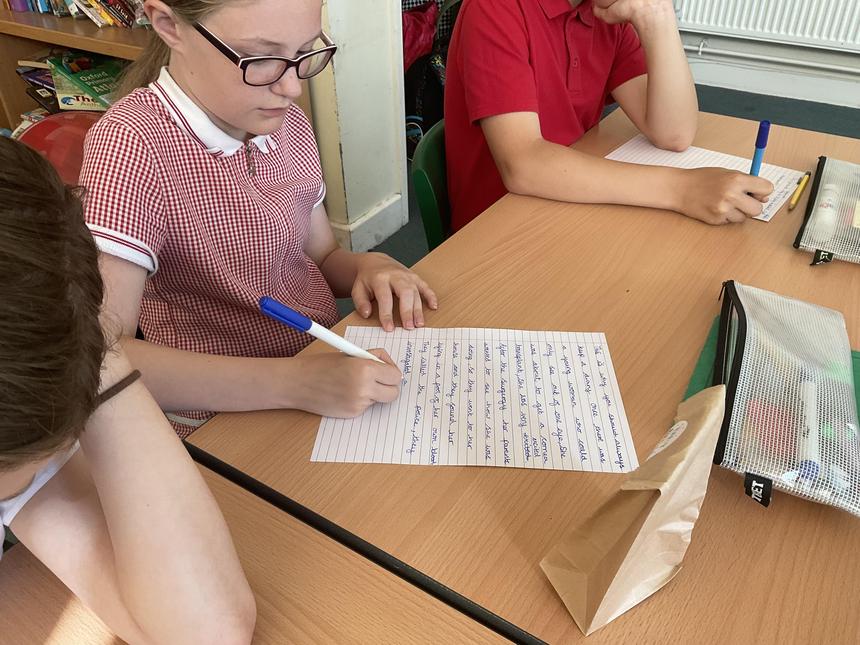Writing
|
|
|
|
INTENT
At Cherry Orchard Primary School, it is our aim to ensure that our pupils develop a love of writing, where they are able to use effective and appropriate vocabulary. We want them to write clearly, accurately and coherently, adapting their language and style for a range of contexts, purposes and audiences. We strive for our pupils to develop independence, where they are able to identify their own areas for improvement in all pieces of writing, editing their work effectively during and after the writing process. We encourage our pupils to communicate orally using Standard English, so that they can apply this accurately to their writing. We also intend to develop writers who are able to confidently use the essential skills of grammar, punctuation and spelling. At Cherry Orchard, we set high expectations for all pupils; to take pride in their work and have a fluent, cursive handwriting style, alongside allowing their imaginations to flourish.
|
|
|
|
IMPLEMENTATION
Writing
To help us to develop confident, enthusiastic writers, teachers plan sequences of learning which last between 3 and 4 weeks. Each Writing sequence is based around a high-quality text and is designed to target the gaps identified through assessment. These sequences are pitched at the expected level for the year group, ensuring that all pupils are exposed to the writerly skills of the curriculum appropriate for their age. We carefully differentiate activities throughout the sequence, to ensure that all pupils can achieve the intended outcome.
Sequences start with Text Exploration. During this stage, children become familiar with the text through a variety of memorable experiences, which are known as the ‘hook’. Children spend time discussing and exploring the text in different ways, enabling them to talk through their ideas before moving on to the writing stage. The texts introduce pupils to new, rich vocabulary which we expect them to apply to their own writing. Children also apply their reading skills to help them retrieve, infer and predict.
Once the pupils are more familiar with the text, the sequence moves on to Skills Teaching. We teach them specific writerly skills which will make their writing effective. Teachers choose several age-appropriate vocabulary, grammar or punctuation focuses from the National Curriculum. The teacher models the writing process and examples are displayed on our working wall, so that pupils can refer to them when writing independently. During this stage of the unit, pupils practise their sentence writing and we encourage them to explain how they know they have been successful and to find areas for improvement, which they then edit using a purple polishing pen.
The final stage of the sequence is Planning, Writing and Editing. At this point, children are taught to use everything they have learned to plan, write and edit a final outcome. This is then shared or celebrated in some form.
High standards of writing in other subjects are expected. Teachers provide varied opportunities across the curriculum to apply the writerly skills taught and to develop stamina. The children write end of unit ‘essays’ for Geography and History, where they answer the over-arching key question for the topic covered. We expect the children to transfer and apply their writing skills, so that these final outcomes are of a high quality.
Spelling
In Early Years and Key Stage One, learning to correctly spell words is closely linked to the sounds they are learning in Read, Write Inc. In Key Stage Two, children follow a structured scheme called Essential Spellings. Children are taught specific spelling rules and are encouraged to apply these rules to spell words correctly. We have high expectations for spelling and expect children to copy spelling accurately, whenever they are displayed.
Handwriting
Letter formation is taught alongside the acquisition of letter sounds in the first instance (through our Read, Write, Inc scheme). From Year 1, we use the scheme Letter Join to support our teaching of handwriting. Whilst they are focusing on the correct formation of each letter, children in Reception and Year 1 print their letters. Children begin to learn cursive handwriting, when ready, in Year 2. This then continues through Year 3 when children can use a pen. All children strive to achieve perfect presentation. All teachers model the Letter Join cursive handwriting when modelling writing for the children and when marking. We use a cursive font for printed sheets and displays.

IMPACT
Our writing curriculum at Cherry Orchard mean children enjoy being authors, writing effectively across a range of genres. Continual CPD and coaching ensures high quality first teaching by passionate and committed staff.
Assessment for learning strategies, alongside verbal and written feedback are used on a daily basis. These will allow a picture to be built up of the pupils’ progress, any areas of strength or weakness which can then be addressed in teachers’ planning. Summative assessment is completed and recorded termly. Children complete independent writing pieces as an outcome of a sequence of work, which are then assessed against our writing criteria. Moderation of teacher assessment is also completed termly within year groups in order to ensure that judgements are accurate. Moderation at the end of year is completed within Rivers Schools. Children who are not on track are rigorously identified for intervention/target teaching which takes place on a regular basis. At the end of KS1 and KS2 teachers use the Teacher Assessment Framework to report Teacher Assessment.





